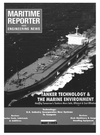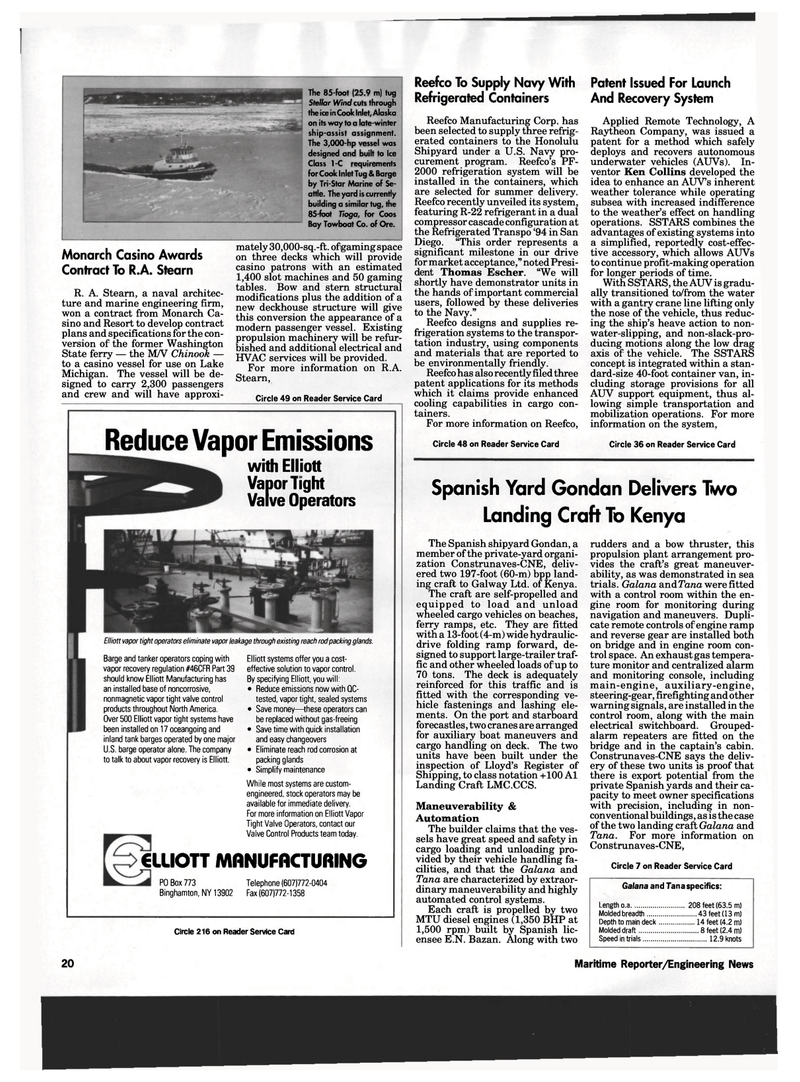
Page 18: of Maritime Reporter Magazine (May 1994)
Read this page in Pdf, Flash or Html5 edition of May 1994 Maritime Reporter Magazine
The 85-foot (25.9 m) tug
Stellar Wind cuts through the ice in Cook Inlet, Alaska on its way to a late-winter ship-assist assignment.
The 3,000-hp vessel was designed and built to Ice
Class 1-C requirements for Cook Inlet Tug & Barge by Tri-Star Marine of Se- attle. The yard is currently building a similar tug, the 85-foot Tioga, for Coos
Bay Towboat Co. of Ore.
Monarch Casino Awards
Contract To R.A. Stearn
R. A. Stearn, a naval architec- ture and marine engineering firm, won a contract from Monarch Ca- sino and Resort to develop contract plans and specifications for the con- version of the former Washington
State ferry — the M/V Chinook — to a casino vessel for use on Lake
Michigan. The vessel will be de- signed to carry 2,300 passengers and crew and will have approxi- mately 30,OOO-sq.-ft. of gamingspace on three decks which will provide casino patrons with an estimated 1,400 slot machines and 50 gaming tables. Bow and stern structural modifications plus the addition of a new deckhouse structure will give this conversion the appearance of a modern passenger vessel. Existing propulsion machinery will be refur- bished and additional electrical and
HVAC services will be provided.
For more information on R.A.
Stearn,
Circle 49 on Reader Service Card
Reduce Vapor Emissions with Elliott
Vapor Tight
Valve Operators
Elliott vapor tight operators eliminate vapor leakage through existing reach rod packing glands.
Barge and tanker operators coping with vapor recovery regulation #46CFR Part 39 should know Elliott Manufacturing has an installed base of noncorrosive, nonmagnetic vapor tight valve control products throughout North America.
Over 500 Elliott vapor tight systems have been installed on 17 oceangoing and inland tank barges operated by one major
U.S. barge operator alone. The company to talk to about vapor recovery is Elliott.
Elliott systems offer you a cost- effective solution to vapor control.
By specifying Elliott, you will: • Reduce emissions now with QC- tested, vapor tight, sealed systems • Save money—these operators can be replaced without gas-freeing • Save time with quick installation and easy changeovers • Eliminate reach rod corrosion at packing glands • Simplify maintenance
While most systems are custom- engineered, stock operators may be available for immediate delivery.
For more information on Elliott Vapor
Tight Valve Operators, contact our
Valve Control Products team today.
CLUOTT MANUFACTURING
P0 Box 773
Binghamton, NY 13902
Telephone (607)772-0404
Fax (607)772-1358
Circle 216 on Reader Service Card
Reefco To Supply Navy With
Refrigerated Containers
Reefco Manufacturing Corp. has been selected to supply three refrig- erated containers to the Honolulu
Shipyard under a U.S. Navy pro- curement program. Reefco's PF- 2000 refrigeration system will be installed in the containers, which are selected for summer delivery.
Reefco recently unveiled its system, featuring R-22 refrigerant in a dual compressor cascade configuration at the Refrigerated Transpo '94 in San
Diego. "This order represents a significant milestone in our drive for market acceptance," noted Presi- dent Thomas Escher. "We will shortly have demonstrator units in the hands of important commercial users, followed by these deliveries to the Navy."
Reefco designs and supplies re- frigeration systems to the transpor- tation industry, using components and materials that are reported to be environmentally friendly.
Reefco has also recently filed three patent applications for its methods which it claims provide enhanced cooling capabilities in cargo con- tainers.
For more information on Reefco,
Circle 48 on Reader Service Card
Patent Issued For Launch
And Recovery System
Applied Remote Technology, A
Raytheon Company, was issued a patent for a method which safely deploys and recovers autonomous underwater vehicles (AUVs). In- ventor Ken Collins developed the idea to enhance an AUVs inherent weather tolerance while operating subsea with increased indifference to the weather's effect on handling operations. SSTARS combines the advantages of existing systems into a simplified, reportedly cost-effec- tive accessory, which allows AUVs to continue profit-making operation for longer periods of time.
With SSTARS, the AUV is gradu- ally transitioned to/from the water with a gantry crane line lifting only the nose of the vehicle, thus reduc- ing the ship's heave action to non- water-slipping, and non-slack-pro- ducing motions along the low drag axis of the vehicle. The SSTARS concept is integrated within a stan- dard-size 40-foot container van, in- cluding storage provisions for all
AUV support equipment, thus al- lowing simple transportation and mobilization operations. For more information on the system,
Circle 36 on Reader Service Card
Spanish Yard Gondan Delivers Two
Landing Craft To Kenya
The Spanish shipyard Gondan, a member of the private-yard organi- zation Construnaves-CNE, deliv- ered two 197-foot (60-m) bpp land- ing craft to Galway Ltd. of Kenya.
The craft are self-propelled and equipped to load and unload wheeled cargo vehicles on beaches, ferry ramps, etc. They are fitted with a 13-foot (4-m) wide hydraulic- drive folding ramp forward, de- signed to support large-trailer traf- fic and other wheeled loads of up to 70 tons. The deck is adequately reinforced for this traffic and is fitted with the corresponding ve- hicle fastenings and lashing ele- ments. On the port and starboard forecastles, two cranes are arranged for auxiliary boat maneuvers and cargo handling on deck. The two units have been built under the inspection of Lloyd's Register of
Shipping, to class notation +100 A1
Landing Craft LMC.CCS.
Maneuverability &
Automation
The builder claims that the ves- sels have great speed and safety in cargo loading and unloading pro- vided by their vehicle handling fa- cilities, and that the Galana and
Tana are characterized by extraor- dinary maneuverability and highly automated control systems.
Each craft is propelled by two
MTU diesel engines (1,350 BHP at 1,500 rpm) built by Spanish lic- ensee E.N. Bazan. Along with two rudders and a bow thruster, this propulsion plant arrangement pro- vides the craft's great maneuver- ability, as was demonstrated in sea trials. Galana and Tana were fitted with a control room within the en- gine room for monitoring during navigation and maneuvers. Dupli- cate remote controls of engine ramp and reverse gear are installed both on bridge and in engine room con- trol space. An exhaust gas tempera- ture monitor and centralized alarm and monitoring console, including main-engine, auxiliary-engine, steering-gear, firefighting and other warning signals, are installed in the control room, along with the main electrical switchboard. Grouped- alarm repeaters are fitted on the bridge and in the captain's cabin.
Construnaves-CNE says the deliv- ery of these two units is proof that there is export potential from the private Spanish yards and their ca- pacity to meet owner specifications with precision, including in non- conventional buildings, as is the case of the two landing craft Galana and
Tana. For more information on
Construnaves-CNE,
Circle 7 on Reader Service Card
Galana and Tana specifics:
Length o.a 208 feet (63.5 m)
Molded breadth 43 feet (13 m)
Depth to main deck 14 feet (4.2 m)
Molded draft 8 feet (2.4 m)
Speed in trials 12.9 knots 20 Maritime Reporter/Engineering News

 17
17

 19
19
